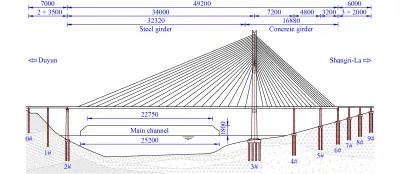
Revolutionizing Bridge Safety: A Breakthrough in Lateral Seismic Isolation for Mountainous Regions!
2025-09-12
Author: Rajesh
As the demand for advanced transportation infrastructure surges in China’s central and western regions, long-span single-tower cable-stayed bridges are emerging as both economical and visually stunning solutions for traversing steep valleys. However, these architectural marvels come with unique challenges, particularly due to their uneven span arrangements, which can complicate their behavior during seismic events.
Frequent, strong earthquakes in these mountainous areas raise significant concerns about the seismic safety of these structures, yet research into effective lateral seismic isolation systems remains scarce. This gap has prompted a groundbreaking investigation by experts from Tongji University and China Highway Engineering Consulting Co., Ltd., focusing on the Jinsha River Bridge to assess and enhance the seismic resilience of such bridges.
The research team—comprising Shichun Zhang, Junjun Guo, Wei Liu, Jibo Li, and Zhongguo Guan—has conducted a thorough analysis of the structural asymmetry inherent to long-span single-tower cable-stayed bridges. Utilizing a sophisticated multilinear model that simulates various hysteresis behaviors, the research delves into optimizing damping mechanisms critical for ensuring stability during earthquakes.
One of the standout findings reveals that an inverted S-shaped hysteresis can significantly improve the seismic performance by effectively balancing the stark differences in lateral stiffness between the towers and piers. This innovative damping approach not only reduces base shear forces but also enhances overall structural integrity.
Additionally, the study employs an influence matrix to determine the ideal yield force for damper systems, establishing a link between this force and the shear forces exerted by bearings in the structural system. This aspect is particularly crucial as it informs engineers how to best enhance a bridge's resilience to seismic activity.
The research also considers various geological conditions—important factors that influence the design of lateral isolation systems. For instance, in areas where side spans cross steep valleys, installing dampers at all tower and pier locations is recommended. Conversely, for gentle valley slopes, a more simplified isolation system may suffice. Notably, the conditions of the site matter significantly, as softer soil will require greater damper yield forces, leading to more substantial seismic responses.
This pioneering study is set to transform how engineers approach the seismic design of bridges in mountainous terrains, potentially saving lives and infrastructure in earthquake-prone areas.





 Brasil (PT)
Brasil (PT)
 Canada (EN)
Canada (EN)
 Chile (ES)
Chile (ES)
 Česko (CS)
Česko (CS)
 대한민국 (KO)
대한민국 (KO)
 España (ES)
España (ES)
 France (FR)
France (FR)
 Hong Kong (EN)
Hong Kong (EN)
 Italia (IT)
Italia (IT)
 日本 (JA)
日本 (JA)
 Magyarország (HU)
Magyarország (HU)
 Norge (NO)
Norge (NO)
 Polska (PL)
Polska (PL)
 Schweiz (DE)
Schweiz (DE)
 Singapore (EN)
Singapore (EN)
 Sverige (SV)
Sverige (SV)
 Suomi (FI)
Suomi (FI)
 Türkiye (TR)
Türkiye (TR)
 الإمارات العربية المتحدة (AR)
الإمارات العربية المتحدة (AR)